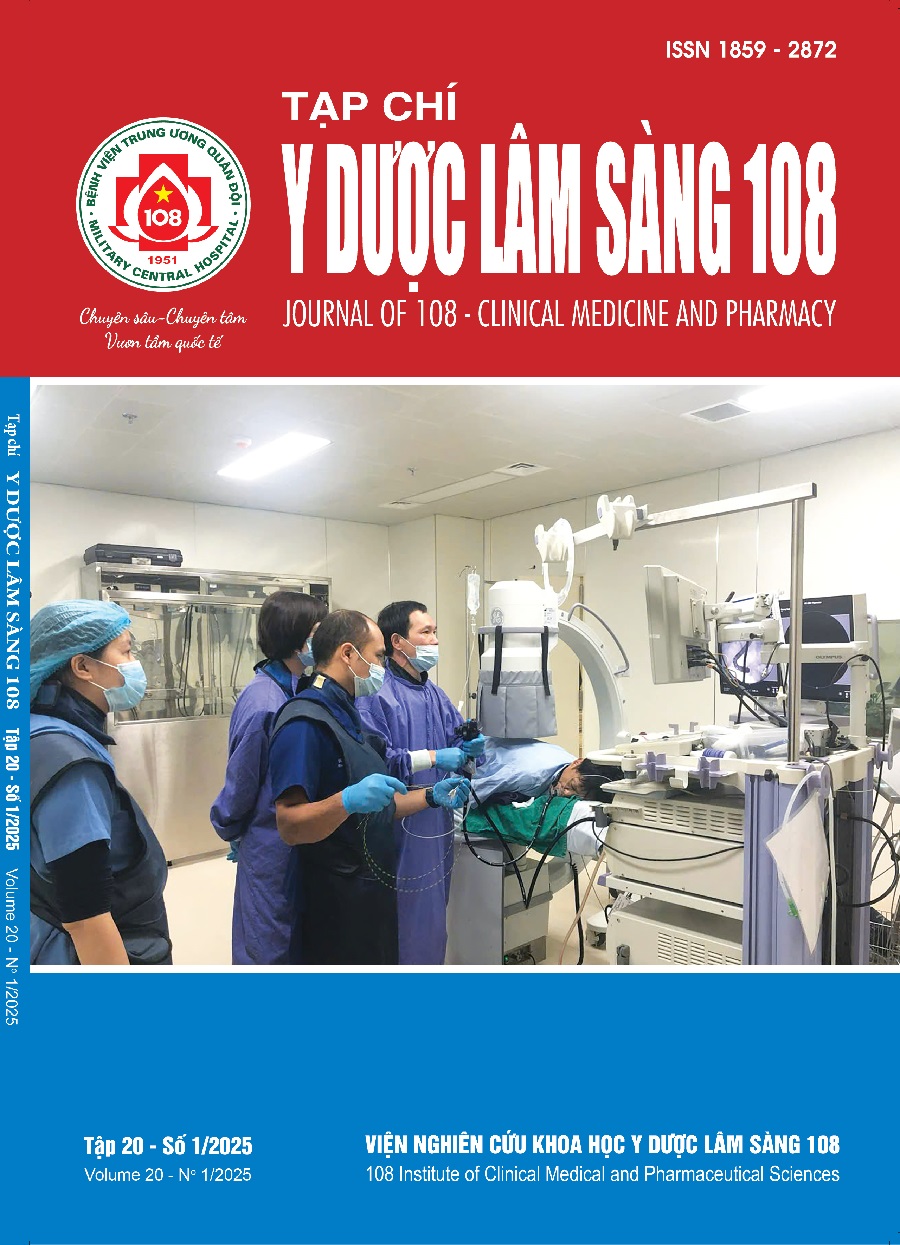Value of Mallampati grade and some risk factors in prediction of hypoxia during deep sedation gastrointestinal endoscopy
Main Article Content
Keywords
Abstract
Objective: To evaluate the value of Mallampati grade (MMP) and some risk factors in prediction of hypoxia during deep sedation for gastrointestinal endoscopy. Subject and method: In a descriptive study, the endpoint was the incidence of hypoxia defined as pulse oxygen saturation (SpO2) < 95% for 10 seconds. A total of 266 patients admitted to Gastrointestinal Endoscopic Department, 108 Military Central Hospital from June 2023 to October 2023 for deep sedation gastrointestinal endoscopy were studied. All patients’ characteristics including age, body mass index (BMI), neck circumference, mouth opening, thyromental distance, sternomental distance and MMP were measured. Patients were divided into hypoxia and non-hypoxia groups based on the SpO2. Result: 17 of 266 patients (6.4%) developed hypoxia, which occurred more frequently in the older group (p<0.01). On regression analysis, the odds ratios (OR) for developing hypoxia were: Age ≥ 60 years (OR = 7.7; p<0.01); MMP III and IV (OR = 4.3; p=0.007); BMI ≥ 23 (OR = 2.86, p=0.003); mouth opening ≤ 4.5cm (OR = 5.03; p=0.02); sternomental distance ≤ 13.5cm (OR = 13.87; p=0.001). No significant correlation was observed between neck circumference or thyromental distance and hypoxia. Conclusion: Age ≥ 60 years, BMI ≥ 23, mouth opening ≤ 4.5cm, sternomental distance ≤ 13.5cm, MMP III and IV were significant risk factors for hypoxia. This combination may allow to anticipate, manage, and consequently decrease the occurrence of hypoxia.
Article Details
References
2. Xiong Y, Yan H, Qu L, Wang S, Meng X, Zhu X, Zhang P, Yuan S, Shi J (2023) Global Trends of Gastrointestinal Endoscopy Anesthesia/Sedation: A Bibliometric Study (from 2001 to 2022) - PMC. J Pain Res 16: 2393-2406. doi:10.2147/JPR.S408811.
3. Goto T, Goto Y, Hagiwara Y, Okamoto H, Watase H, Hasegawa K (2019) Advancing emergency airway management practice and research. Acute Med Surg 6(4): 336-351. doi: 10.1002/ams2.428.
4. S PK, Kagalkar N, Holyachi R, Suntan A (2021) Ratios of Height-to-Thyromental Distance and Height-to-Sternomental Distance as Predictors of Difficult Airway in Patients Posted for General Anaesthesia. Asian J Anesthesiol 59(2): 69-75.
5. Qadeer MA, Rocio Lopez A, Dumot JA, Vargo JJ (2009) Risk factors for hypoxemia during ambulatory gastrointestinal endoscopy in ASA I-II patients. Dig Dis Sci 54(5): 1035-1040. doi:10.1007/s10620-008-0452-2.
6. Pozin IE, Zabida A, Nadler M, Zahavi G, Orkin D, Berkenstadt H (2023) Respiratory complications during recovery from gastrointestinal endoscopies performed by gastroenterologists under moderate sedation. Clin Endosc 56(2): 188-193. doi:10.5946/ce.2022.033.
7. Choe JW, Hyun JJ, Son SJ, Lee SH (2024) Development of a predictive model for hypoxia due to sedatives in gastrointestinal endoscopy: A prospective clinical study in Korea - PMC. Clin Endosc 57(4): 476-485. doi:10.5946/ce.2023.198.
8. Bộ Y tế (2022) Quyết định 2892/QĐ-BYT tài liệu Hướng dẫn chẩn đoán và điều trị bệnh béo phì.
9. Vargo JJ (2009) Procedural sedation and obesity: Waters left uncharted. Gastrointest Endosc 70(5): 980-984. doi:10.1016/j.gie.2009.07.003.
10. Al Ramadhani S, Mohamed LA, Rocke DA, Gouws E (1996) Sternomental distance as the sole predictor of difficult laryngoscopy in obstetric anaesthesia. Br J Anaesth 77(3): 312-316. doi:10.1093/bja/77.3.312.
11. Prakash S, Mullick P, Bhandari S, Kumar A, Gogia AR, Singh R (2017) Sternomental distance and sternomental displacement as predictors of difficult laryngoscopy and intubation in adult patients. Saudi J Anaesth 11(3): 273-278. doi: 10.4103/1658-354X.206798.
 ISSN: 1859 - 2872
ISSN: 1859 - 2872
